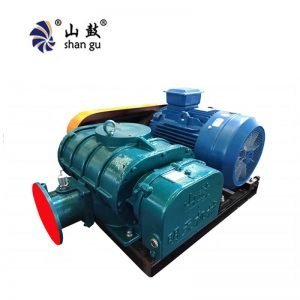Five Factors To Consider When Choosing A Roots Blower. The selection of Roots blower is the same as that of other fans. It is necessary to know certain parameters to determine the blower type. As a pneumatic conveying device, it is widely used in the chemical industry, metallurgical industry, and the environmental protection industry. When choosing the model, we must calculate the technical parameters precisely. If the model is too big, it will waste power and capital; too small can not meet the requirements of working conditions. Let’s discuss with you the following parameters, which will influence the selection of roots blowers.
1. Air Volume
The airflow parameter refers to the volume of gas delivered by the roots blower per unit time. The general unit of measurement is: m³/min or m³/h. In some industries, the roots blowers are only auxiliary equipment, and it is impossible to estimate the required air volume parameters, such as cement transportation and boiler return. Under these conditions, it is only possible to provide the delivery volume per unit time, such as: conveying 15 tons of cement per hour; the material throughput data can also help us estimate the air volume. The air volume parameter is one of the parameters that must be mastered when the Roots blower is selected.
2. Pressure
The pressure parameter refers to the outlet pressure of the Roots blower and also refers to the pressure that the Roots blower needs to overcome. The Roots blower itself does not generate pressure. Its ability to overcome the pressure of the front pipeline, we call it “Roots Blower pressure.” Because the Roots blower is a positive displacement blower, the pressure depends on the front pipe and atmospheric pressure, which is what we often call “back pressure”. The pressure gauge will show the exact pressure. If the pressure exceeds the rated pressure, the Roots blower will be in an overpressure condition and the motor will burn down easily.
The above two parameters are the necessary parameters for the selection of Roots blower. The following parameters are also very important. What are the parameters?
3. Rotate Speed
There are two main transmission modes for Roots blowers. One is belt drive and the other is direct drive. In some industries, there are strict requirements for the speed of the Roots blower. So, what effect does the rotary speed have on the blower?
The Rotate speed affects two aspects, one is the air volume, and the other is the service life of the blower. When all the parameters are the same except the rotate speed, the higher the speed, the larger the blower volume. However, the abrasion of the blower will be more serious. We can say that the blower with high speed will be shorter in service life. From this point we can know the importance of the speed parameter.
4. Transport Medium
The roots blowers can not transport all kinds of gas, such as gas with High acidity and alkalinity and flammable and explosive gases. For example: strong corrosive gas. We can manufacture the roots blowers with special material, but the strong corrosive gas can damage the roots blower easily. In this case, the blower is not suitable for these working conditions. Most of the roots blowers in the market are made from cast irons and stainless steel with their own application standard. Therefore, when selecting according to the air volume and pressure, there are certain requirements for the transport medium.
5. Sealing Method
We also need to consider one parameter: the sealing method. Generally, the sealing method of Roots blowers are labyrinths. However, when special gases are transported, special sealing methods such as piston ring seals and mechanical seals may be required. The difference in the sealing method will cause the price of the model to fluctuate, which is also one of the necessary parameters for selection.
Above are the parameters that must be considered when the Roots blower is selected. Only selected according to the parameters can the Roots Blowers meet your requirements.

